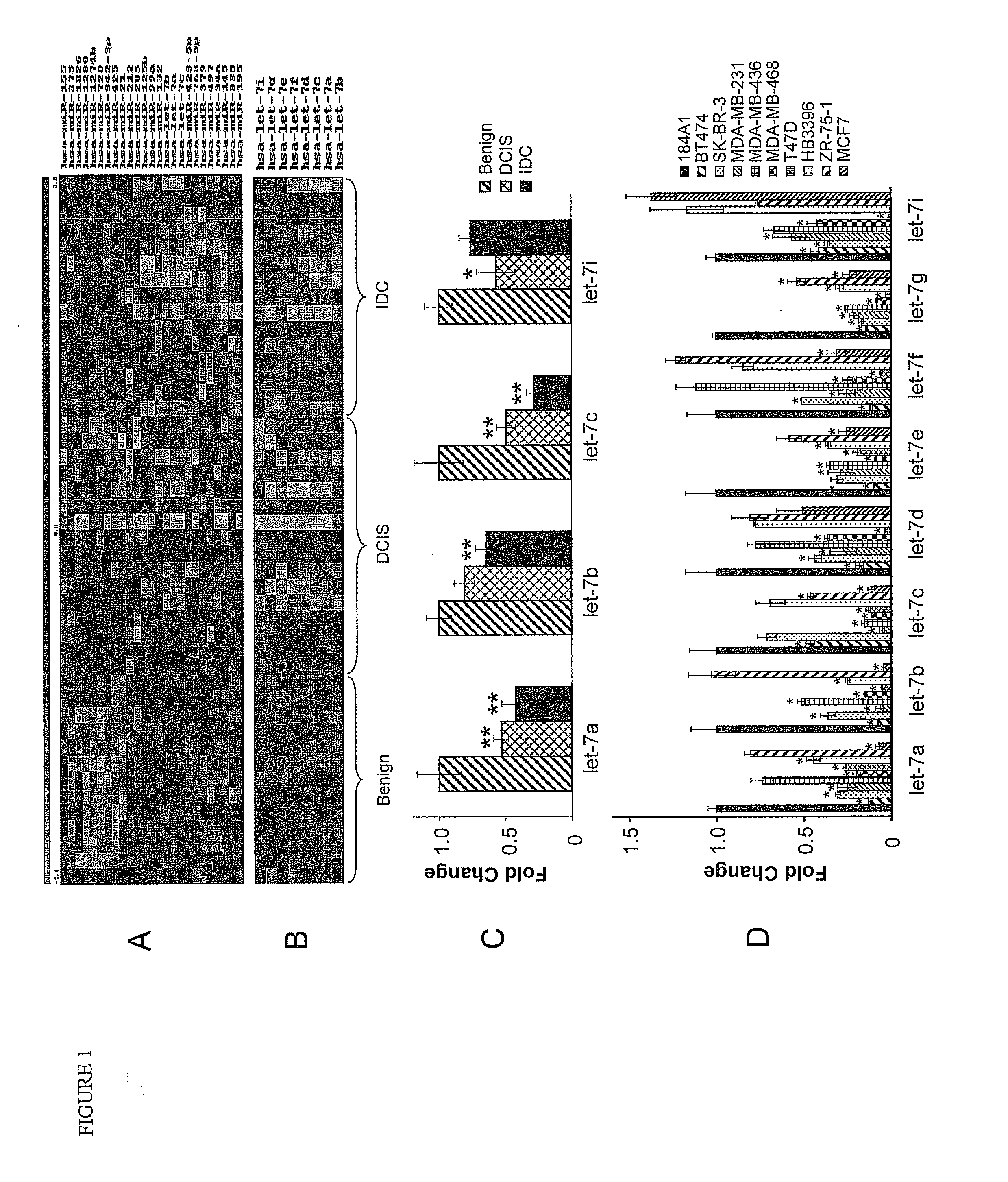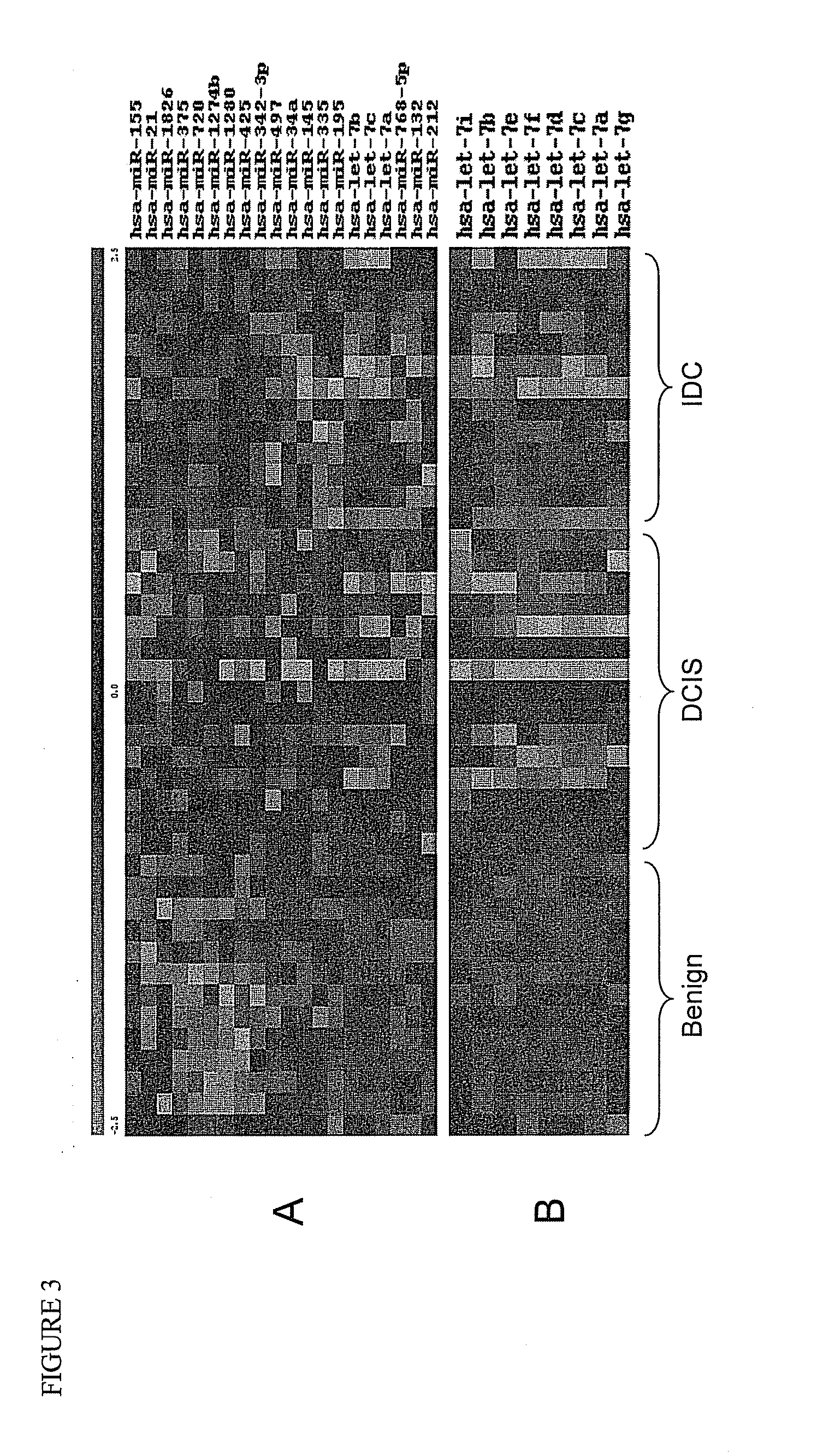Polynucleotides for use in treating and diagnosing cancers
a technology of polynucleotides and cancer, applied in the field of polynucleotides for use in treating and diagnosing cancer, can solve the problems of unreachable detailed mechanisms underlying the regulation of let-7 in breast tumorigenesis
- Summary
- Abstract
- Description
- Claims
- Application Information
AI Technical Summary
Benefits of technology
Problems solved by technology
Method used
Image
Examples
example 1
Let-7 Family miRNAs Regulate Estrogen Receptor Alpha Signaling in Breast Cancer
[0129]To understand how microRNAs (miRNAs) regulate breast cancer tumorigenesis, a RNA expression microarray screening was performed using RNA from formalin-fixed paraffin-embedded (FFPE) breast tissues, which included benign (n=13), ductal carcinoma in situ (DCIS) (n=16), and invasive ductal carcinoma (IDC) (n=15). Twenty-five differentially expressed miRNAs (p<0.01) were identified, of which let-7 family miRNAs were down-regulated in human breast cancer tissues at stages of DCIS and IDC compared to benign stage. It was further found that there was an inverse correlation between ER-α expression and several members of let-7 family in the FFPE tissues. Next, bioinformatics analysis was performed and it was found that let-7 miRNA sequences match sequence in the 3′ UTR of estrogen receptor alpha (ER-α), suggesting ER-α may be a target of let-7, which was further confirmed by a number of experimental assays, ...
example 2
Let-7 microRNAs Induce Tamoxifen Sensitivity by Down-Regulation of Estrogen Receptor Alpha Signaling in Breast Cancer
[0160]MicroRNAs (miRNAs) play an important regulatory role in breast tumorigenesis. Previously, we found that let-7 miRNAs were significantly downregulated in formalin fixed paraffin-embedded (FFPE) breast cancer tissues (Example 1). In order to further understand the potential role of let-7 miRNAs in breast cancer tissues, we found that endogenous levels of let-7 family miRNAs are inversely correlated with levels of estrogen receptor (ER)-α36, a new variant of ER-α66, in the FFPE tissue set. Bioinformatic analysis suggested that ER-α36 may be also a target of let-7 miRNAs. To test this hypothesis further, cotransfection of let-7 mimics with ER-α36 3′ UTR luciferase construct was performed, and we found that let-7 mimics suppressed the activity of reporter gene significantly, which was restored remarkably by let-7 inhibitors. Transfection of let-7 mimics inhibited bot...
example 3
microRNAs Let-7 can be Used as Biomarker for Early Detection of Breast Cancer
[0181]Results from our previous studies and others showed that endogenous miRNAs are expressed differentially in breast cancer tissues at various stages, suggesting that these miRNAs can be developed as potential biomarkers useful for early diagnosis, prognosis, and therapy of breast cancer (Zhao et al., 2010, Breast Cancer Res. Treat. DOI: 10.1007 / s10549-010-0972-2, Mitchell et al., 2008, Proc. Natl. Acad. Sci. U.S.A 29; 105:10513-8, Heneghan et al., 2010, Ann. Surg. 251:499-505). Recent reports confirmed the association between differentially expressed miRNAs and several clinicopathologic features, including mRNA expression-based classification (Blenkiron et al., 2007, Hum. Mol. Genet. April 15; 16 Spec No 1:R106-R113), tumor grade, and clinical stage scoring (Iorio et al., 2005, Cancer Res. 65:7065-70). Generally, these miRNAs related to cancer can be classified into two categories: tumor suppressors (e....
PUM
| Property | Measurement | Unit |
|---|---|---|
| volume | aaaaa | aaaaa |
| thick | aaaaa | aaaaa |
| volume | aaaaa | aaaaa |
Abstract
Description
Claims
Application Information
 Login to View More
Login to View More - R&D
- Intellectual Property
- Life Sciences
- Materials
- Tech Scout
- Unparalleled Data Quality
- Higher Quality Content
- 60% Fewer Hallucinations
Browse by: Latest US Patents, China's latest patents, Technical Efficacy Thesaurus, Application Domain, Technology Topic, Popular Technical Reports.
© 2025 PatSnap. All rights reserved.Legal|Privacy policy|Modern Slavery Act Transparency Statement|Sitemap|About US| Contact US: help@patsnap.com



